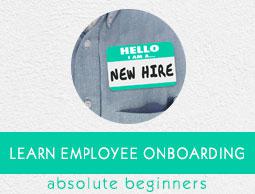Employee Onboarding - Introduction
Onboarding is a comprehensive process for integrating newly appointed employees in an organization and familiarizing them with the organizational culture and work environment. It is an integral part of Human Resources Department (HRD). Lack of appropriate onboarding mechanism can have negative impact on the overall productivity of the organization.
Employee onboarding is essential to retain skilled and dedicated workforce. An employee onboarding program helps in the orientation of the new employees. It shapes the relation between the new employee and the organization. By implementing a good employee onboarding program, will build a strong organization culture and secure the future with a qualified pool of human resources.
Employee onboarding is a composite process; it is more than just the orientation of new employees. Employee orientation is the first step in the onboarding process. In larger sense, onboarding process aims at developing a happy and constructive relationship between the employee and the employer. It represents the organizational values, brand and also explains the professional culture and the work environment.

Employee onboarding aligns the expectations of the employees and the goals of the organization and provides a phase, where the new employees successfully get acquainted with the organization, old employees and the work environment. This will result in faster productivity in the short span of time.
What is Employee Onboarding?
Employee onboarding can be defined as a process that helps the newly recruited human resources to get acclimatized with organizational culture, work environment and goals. This helps in learning the attitudes, gaining knowledge & skills and also the behaviors required for the effective function of the work within the organization.
When it comes to job satisfaction, financial rewards may be lower on the list than most people think. Being happy with your job seems to depend more on the intangibles: feeling part of a team and being valued and appreciated consistently outrank money when employees are polled about job satisfaction. Employee onboarding process is the first step towards development of such feelings and values.
Employee Onboarding can also be defined as follows −
Onboarding is a strategic process of bringing a new employee to the organization and providing information, training, mentoring and coaching throughout the transition. The process begins at the acceptance of an offer and throughout the first six to twelve months of employment.”
Onboarding, also known as organizational socialization, refers to the mechanism through which new employees acquire the necessary knowledge, skills, and behaviors to become effective organizational members and insiders.
In short, employee onboarding involves the processes, which helps to ensure that the new human resources get started on the right foot. How can a stranger know our home unless we politely let him in?
Formal Onboarding
Formal onboarding includes selective assignments and strategies that help a new employee change in accordance with his or her new position. Under formal on-boarding, new employees are frequently isolated from existing representatives to encounter facilitated exercises for introduction, in-classroom preparing and socialization.
Informal Onboarding
Informal onboarding alludes to the specially appointed and semi-sorted out exercises by which new employee finds out about his or her new employment. Casual onboarding can incorporate employment shadowing and unrehearsed one-on-one instructing or gatherings with administration and new associates, and in addition the details of beginning at an organization, for example, accepting identifications and equipment.
Note − Monster.com reports 30% of external new hires turnover within the first two years of employment. Retention statistics from other organizations, including the Society for Human Resources Management (SHRM), show that the turnover can be as much as 50% in the first 18 months of employment.



